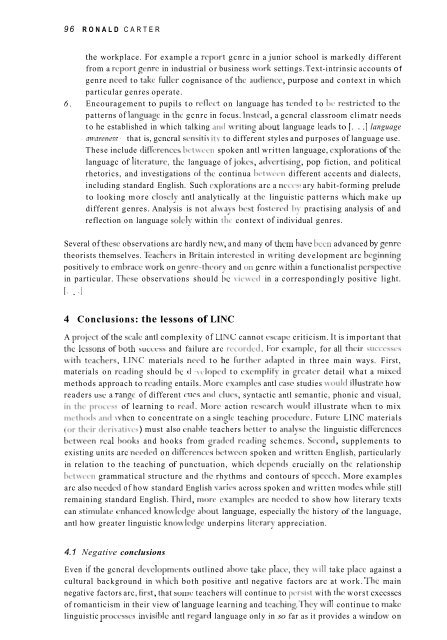Download - Search
Download - Search
Download - Search
Create successful ePaper yourself
Turn your PDF publications into a flip-book with our unique Google optimized e-Paper software.
1 of96 RONALD CARTER6.the workplace. For example a rcport gcnrc in a junior school is markedly differentfrom a rcport genre in industrial or business work settings. Text-intrinsic accounts ofgenre need to take fullcr cognisance of the audiencc, purpose and context in whichparticular genres operate.Encouragement to pupils to rcllcct on language has tendcd to lie restrictcd to thepatterns of IanguagcT in the gcnrc in focus. Instead, a gcncral classroom climatr needsto he established in which talking and writing almut language leads to [. . .] languageairureness ~ that is, gcncral scnsiti\ it\. to different styles and purposes of language use.These include tliffcrcnces lxtmwn spoken antl written language, cxplorations of thelanguagc of literature, thc language of jokes, advertising, pop fiction, and politicalrhetorics, and investigations of’ the continua I>ct\vccn different accents and dialects,including standard English. Such cxplorations arc a nc ary habit-forming preludeto looking more closely antl analytically at the linguistic patterns \vhich make updifferent genres. Analysis is not al\vays best fostcrcd by practising analysis of andreflection on language solely within the context of individual genres.Several of these observations arc hardly ncw, and many of’thcrn have been advanced by genretheorists themselves. Teachers in Britain intcrestctl in lzriting development arc bcginningpositively to emlracc xzork on gcnrc-theory and on gcnrc bvithin a functionalist pcrspcctivcin particular. Thcsc observations should I>c vicwwl in a correspondingly positive light.I. . .I4 Conclusions: the lessons of LINCA project of the scale antl complexity of LlNC cannot escape criticism. It is important thatthe lessons of both succcss and failure arc ix~ot-dcd. 1:or cxamplc, for all their SUCC~SSCS\vith tcachers, LINC materials ncctl to he further adapted in three main ways. First,materials on reading should Iic tl lopctl to cxcmplify in grcatcr detail what a mixedmethods approach to rcding entails. Morc examples antl case studies ~-ould illustratc howreaders use a rangc- of different cucs and cluc-s, syntactic antl semantic, phonic and visual,learning to read. Morc action rescarch \voultl illustrate when to mixvhcn to concentrate on a xinglc teaching ptwccdurc. Future LINC materials) must also cnablc teachers Iictter to analysc the linguistic tliffcrcnccsbetween real books and hooks from gr-adctl reatling schcmcs. Sccontl, supplements toexisting units arc ncccletl on diffcrenccs bct\vccn spoken and Lvrittcn English, particularlyin relation to the teaching of punctuation, which depends crucially on the relationshipIiet\vccn grammatical structure and the rhythms and contours of spccch. More examplesarc also nccdcd of how standard English varies across spoken and written modcs hvhile stillremaining standard English. Third, inorc cxxaniplcs arc nccdctl to show how literary textscan stimulate enhanced kno\vlcdgc about language, especially the history of the language,antl how greater linguistic kno\vlcdgc underpins literary appreciation.4.1 Negative conclusionsEven if the gcncral tlcvclopmcnts outlined ahovc take placc, they \vi11 take placc against acultural background in lvhich both positive antl negative factors arc at work. The mainnegative factors arc, first, that some teachers will continue to pcmist with the worst cxccsscsof romanticism in their view of language learning and tcaching.l’hcy will continue to makelinguistic processes invisildc antl regard language only in so far as it provides a \vindo\v on


